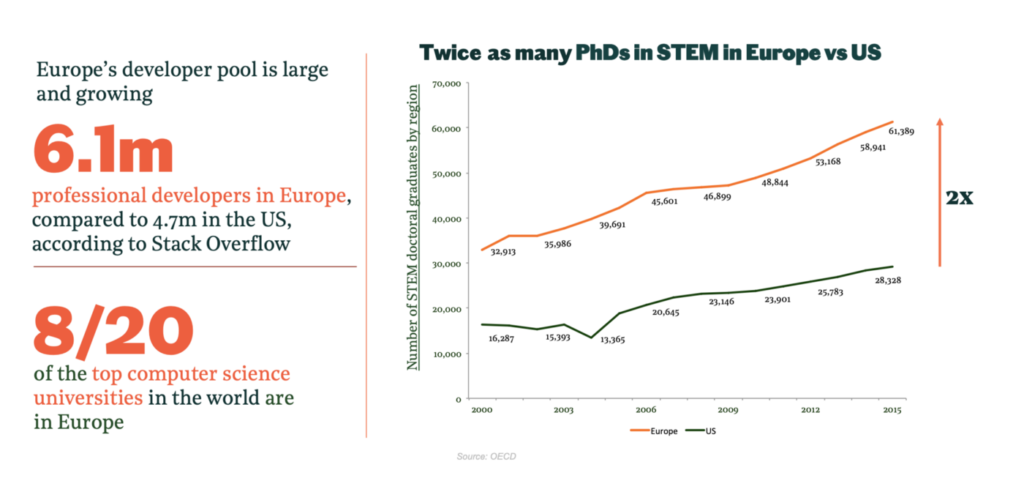A brief rant into some of the trends sweeping the software world and highlighting some of the coolest European companies making the most of those trends.
Developers are the most important decision-makers in the software ecosystem, and, as software eats the world, the most important decision-makers in business. That sentence would have been controversial 10 years ago, now it’s banal.
Developers have always been the builders of software products but they were rarely the primary user and they certainly haven’t always been the people calling the shots around how things get built and what gets bought. It’s been a long time coming but you could probably say that the ‘rise of the developer’ was first publicly recognised about 21 years ago.
Much has changed since the year 2000. Stocks have gone down. Then back up. Founders of the biggest tech companies in the world have lost their youthful barnets and in some cases grown them back. Microsoft has gone from the enemy of many an IRC channel filled with Linux death eaters to the beloved brother of those whose preferred form of social interaction is the command line. That important shift in strategy from the most influential software company in the world was announced on the 12th of July 2000 when Steve Ballmer went on stage to scream into the void; ‘Developers! Developers! Developers!’
The rise of the developer
As an industry, venture tends to be a little late to the party and it was 2015 before many leading VCs began publishing blogs alongside their early major investments in the developer-focused world with strong retrospective investment strategies around the ‘rise of the developer ‘— as if the CEO of the largest technology company in the world hadn’t been roaring this in public 15 years prior.
So, what has the ‘rise of the developer’ changed about the world? It’s unlocked a spectacular amount of latent value in software markets and has allowed for step-change in the speed at which software products can be delivered, the quality that they can attain and the enormous scale to which they can be rolled out. It has been a long march that is only accelerating and as software becomes easier to build, developers become more influential. Frameworks like React and Next.js. Hosting and DevOps automation tools like Netlify and Render. DBs like Mongo and Cockroach. These innovations simplify software and give each developer the ability to build products that would have taken a small army not that long ago.
The secular trends of developers as decision-makers and the primary user of software shifting from people to other software are shifting the ground beneath our feet. It’s easier than ever to scale a product to millions of users with a 10 person team — you need look no further than Clubhouse’s use of Agora to see that the developer and infrastructure revolution is here (they have ONE full-time iOS dev!) and it’s opened up opportunities to take on the consumer internet giants. Their infrastructure was as much a moat as their network effects. Those days are now over.
Europe's Role in the software revolution
For all the advantages Europe has had in terms of talent, academia and a few big outcomes we’ve lagged the world in turning those advantages into commercial results. Linus Torvalds gave the software world perhaps two of it’s greatest gifts in the Linux kernel & git — but while those technologies originated in Europe, it was American companies like Github and RedHat that captured much of the enormity of the value created by the underlying continental tech.

Europe has one of the largest developer ecosystems in the world. We benefit from an extremely well funded public university system from undergrad through to PhD. Many of these University programs are ranked at the top of the world. Yet we have no Stanford equivalent.
Europe has had some big exits. MySQL was a huge win for the Nordics until it turned out that not that many people outside the founders inner circle made all that much money from it. Elastic was another mega win. The first major IPO of a developer led, open source core product in Europe. But these wins are isolated. Flickering sparks in the night start few blazing fires.

There is no MySQL mafia. For every 100 ex/ BCG Rocket Internet alumni raising a seed round for their latest productivity tool, there’s 1 Elastic SRE contemplating a startup. The flywheel of innovation just hasn’t started spinning yet. But that’s changing. It’s changing in a big way.
More and more US companies are basing their engineering and product teams in Europe. More and more European developers are seeing the opportunity not just to build something for fun or work for someone else but to start something themselves. Finally, enough VCs ‘get’ developer-focused companies. They might not understand how they work but they know there’s money to be made. And, to be honest, that’s more than half the battle.
It’s this environment of expertise, ambition, opportunity and capital that I think is going to produce a generation of massive European developer-focused (they’re not all strictly DevTools) companies. There’s so many in fact that I have to split them into groups and for all the VC associates short on deal flow this week well, aw jeez, is it your lucky day. (PS: I’m going to talk my book here, so bear with me.)
Security / Privacy
Security and privacy are some of the fastest-growing segments in the developer-focused world. Accelerated thanks to regulation, more sophisticated threats and the realisation of just how valuable our data has become. London launched unicorn Synk broke out by accelerating a grassroots movement in the dev world, shift-left, and making it it’s own. Irish born evervault has drawn huge attention with its mission to make it as easy to build encrypted products as it is not.
Notable mentions: Tines / Akeero / 418sec / Apheris / GitGuardian / Onsecurity / Hackthebox / Mondoo / CrowdSec
Infrastructure
There are A LOT of companies in the infrastructure world. As software has gotten more complex you need a lot of software to make it work. Companies like Cloudsmith enable software teams to distribute their applications and assets around the world securely at lightning-fast speeds. European VC was so besotted with chaos engineering that Chaosmesh & ChaosIQ were both funded back to back. Prisma is changing the way teams build web apps with Node out of Berlin and m3o wants to take away the hassle of DevOps completely.
Notable mentions: Roadie / Spacelift / Checkly / Deta / Appwrite /
Artillery/ Baserow / Northflank / Phluto / Digger / Bip / NUXTjs / Unleash/ Bearer / Kubestack / QuestDB
Product
Data
Machine learning
ML and its applications will be some of the most transformative technologies of the next decade. We’ve seen ML in applications for a long time from the largest companies in the world but the democratisation of technology and tooling is allowing smaller companies to launch products. The likes of HumanLoop make it easy to work with NLP and companies like Layer, Datrics and Valohai are working on solving challenges with workflows.
Notable mentions: LogicalClocks / Rasa / Fluidstack / Seldon
API For X
Tools for Development
Automation
The Next European Decade
This is by no means an exhaustive list. It’s just a snapshot of some of the developer-focused companies I’ve come across in the past 18 months. But from what I’ve seen I truly believe Europe can go toe to toe with the rest of the world in this sector, just like we have in fintech, to produce some huge outcomes for founder, investors and employees.
Many companies are already reaching escape velocity and when they do you can be sure they’ll seed the ecosystem with a new generation of founders with the skill set and the resources to build even better companies. So if you’re an investor, you’d be crazy not to be looking in this space in Europe. If you’re a potential founder, you’d be a little crazy not to take the plunge. If you’re thinking of joining a startup? There’s a bunch of rocket ships about to take off so I’d get on one now while the going is good.
There are likely many more companies to be added to this list so hit me up on [email protected] if I’ve missed you.
Thanks to Luke Byrne, Philipp Moehring, Lola Wajskop, Avery Klemmer and the Frontline team (Caro) for reviewing this and sharpening it up!

